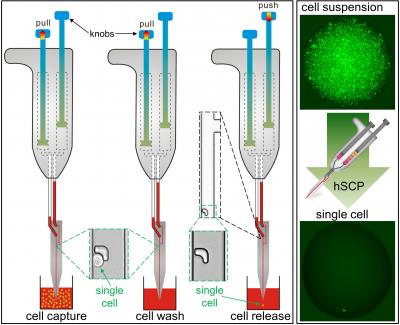Aug 20 2014
Scientists at the Houston Methodist Research Institute have figured out how to pick up and transfer single cells using a pipette -- a common laboratory tool that's been tweaked slightly. They describe this engineering feat and preliminary test results in a recent issue of the Journal of the American Chemical Society.
 This image depicts the dispensing single cells into commercial 96-well plates by hand-held single-cell pipet (hSCP). The insert demonstrates the process of single-cell capture and release. Credit: Lidong Qin laboratory
This image depicts the dispensing single cells into commercial 96-well plates by hand-held single-cell pipet (hSCP). The insert demonstrates the process of single-cell capture and release. Credit: Lidong Qin laboratory
"Studying single cells and their unique functions has become a frontier in current biomedical research," said nanomedicine department. faculty member Lidong Qin, Ph.D., the project's principal investigator. "One of the biggest challenges for single-cell research is picking out only one cell from a collection of millions of cells. Cells are not only small, but also flexible in mechanics and variable in size; which are then extremely difficult for researchers and clinicians to capture single ones."
Zhiqiang Wang, Ph.D., professor of chemistry at Tsinghua University in Beijing, also contributed to the project.
Typical pipettes are fancy syringes used in laboratories to withdraw and deposit liquids, such as pure water or to transfer suspensions of bacterial cells into growth broth. Some pipettes can translate coarse movements of the user's thumb into fine, exact, push-pull actions; other pipettes can be hard-programmed to manipulate exact volumes of liquid down to mere nanoliters, or billionths of a liter.
Few technologies exist that allow researchers to withdraw single animal or bacterial cells from a tube or Petri dish, and those that do exist are cumbersome, expensive, and can be extremely time consuming to use, Qin said. That's why he and his group developed the handheld single-cell pipette, or hSCP.
"Some old and clumsy methods are used to capture single cells," he explained. "Some researchers use their mouths at one end of the pipette, driven by their own mouth force, to try to ensure only a minimum amount of cell suspension collected. The sample is then checked with a microscope to find out the number of cells captured. The opportunity to get only one cell is hit or miss and a bit troublesome.
"One company provides a million-dollar machine that can help biologists transfer single cells to 96-well plates. Each run costs an additional $1,000 to purchase the plate. Such technology will not be widely accessible to biologists."
The prototype of Qin's hSCP has two plungers (see figure). The first plunger withdraws fluid from a suspension of cells. Fluid travels through canals on either side of a nanoscopic, laser-sculpted "hook" that is just big enough to trap one cell. This hook can be altered depending on the size and type of cells a researcher is interested in. The first plunger is also used to wash and separate the captured cell from other cells that may have been extracted. The second plunger pushes the captured cell out of the pipette, possibly into growth medium, or onto a slide or welled plate for study.
Qin said one of his goals is to make the technology cost $10 or less per run. Future designs of the hSCP will be developed with mass production in mind. Qin said his group can also produce hSCPs that pick up virtually any small number of cells depending on a scientist's needs by etching more hooks during the pipette's construction.